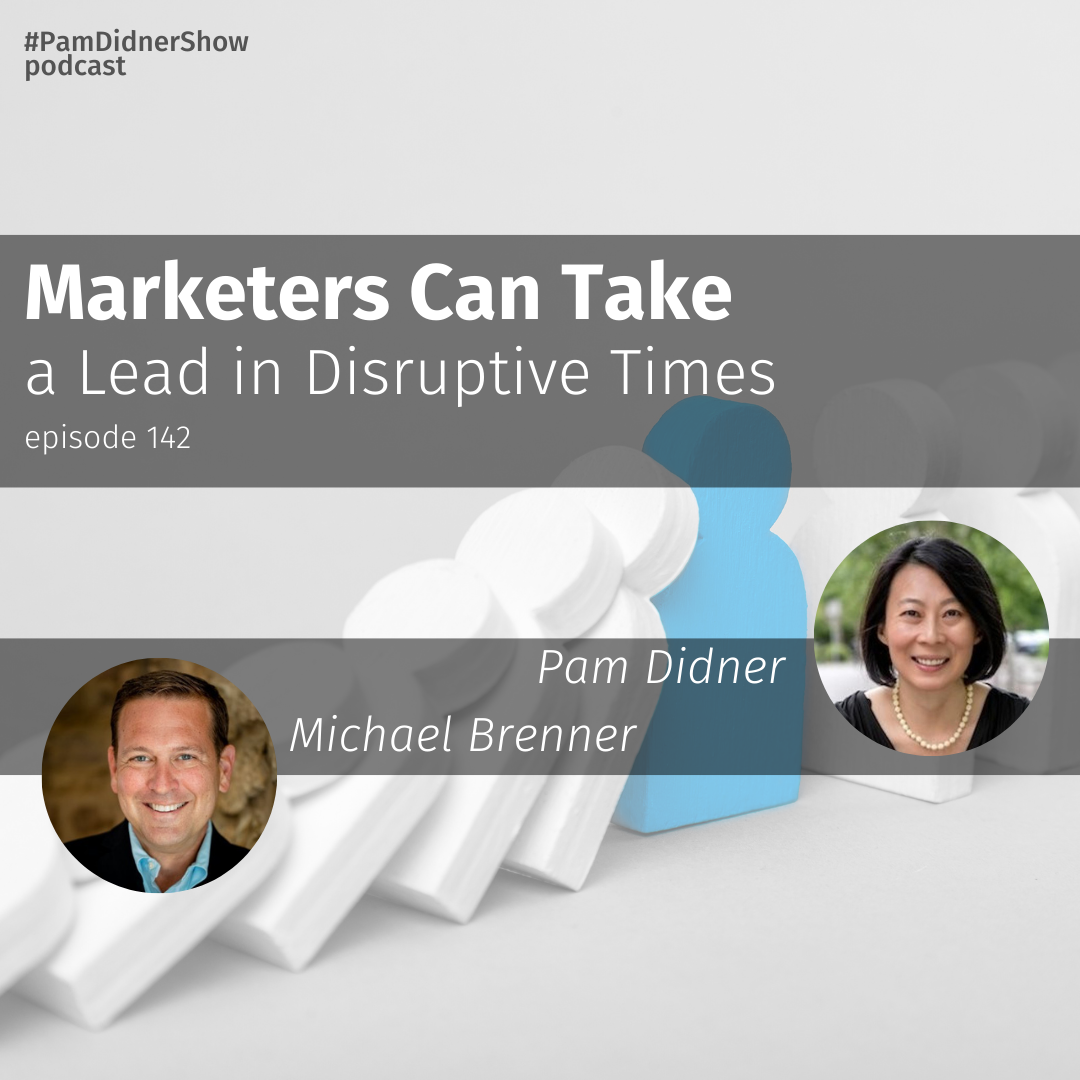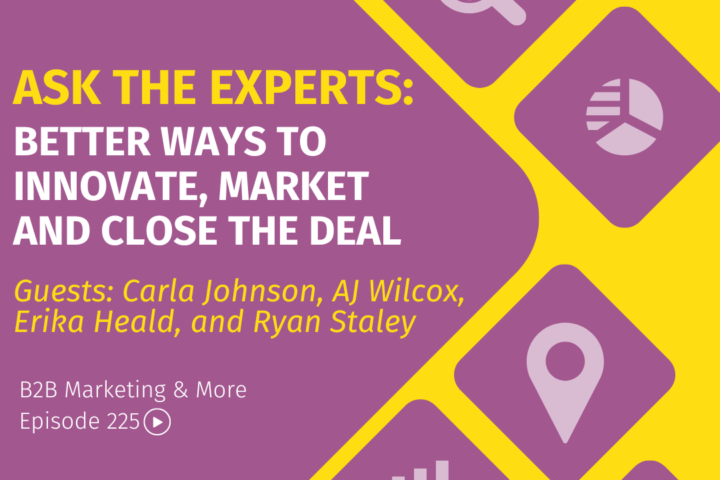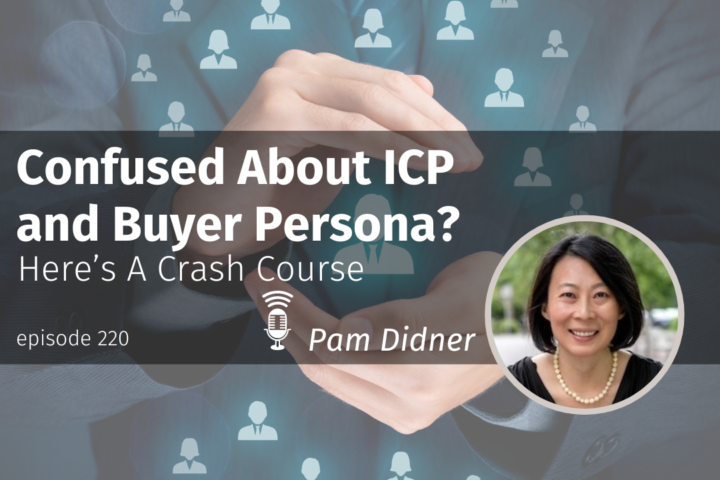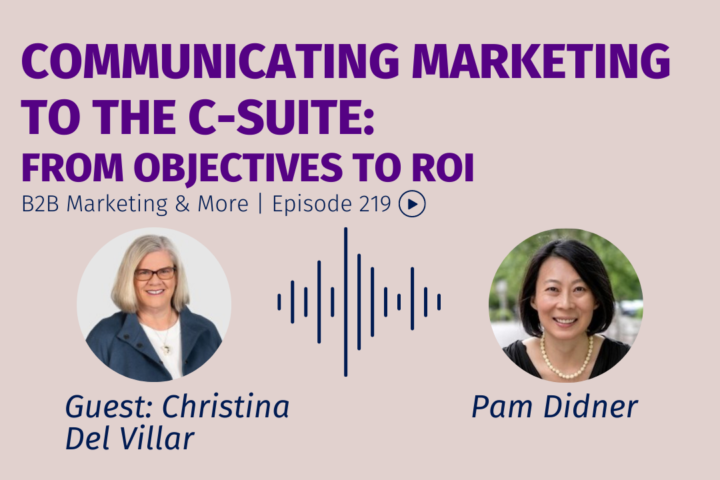
Today I have a special, special, guest. It’s a very good friend, Michael Brenner. And he’s a CMO influencer, motivational speaker. He is the owner of the Marketing Insider Group. There’s a lot of useful contents regarding content marketing, search marketing. So anything digital marketing related. Michael is also a speaker and author, former marketing leader (SAP, Nielsen, Startups), helping companies attract and win new customers with strategic content.
Welcome, Michael.
In this episode:
- How is the B2B marketing landscape doing as a whole in the changing environment
- How can marketers use the context to win new customets
- What are the benefits of sales and marketing alignment and using ABM
- What should marketers and brands focus on when reaching out to customers
- How to shift the focus on customer retention
- When making changes what should marketers do first
- What questions should marketers ask what should they be doing at a tactical level for 2021
Quotes from the episode:
“The best way to get profit is to focus on customers, and the best team that can lead that transformation is marketing.”
“Have a plan to address those [sales] challenges, create the context for your solutions. And ask the sales team what their greatest challenges are. Quantify and create strategies to address them. That’s it? Simple stuff.”
—————
Enjoy the podcast? Subscribe to the show on your favorite podcast platform or leave a 5-star review and subscribe to Apple Podcasts.
If you prefer watching a video, I also have a YouTube Channel, check it out and subscribe.
If you want to chat, reach out to any social media channels or email me hello@pamdidner.com. You can also join my Facebook community: Build Your Marketing Skills to Get Ahead.
To keep on expanding your knowledge about Marketing, and how to lead through disruption, check out some of my previous podcast episodes.
Prepare for Future Disruptions with a Marketing Continuity Plan
Tips to Build Your Recovery Marketing Strategy
How Should I Do Marketing During a Crisis?
TRANSCRIPT
Welcome to this episode of B2B Marketing and More. Today I have a special, special, special guest. It’s a very good friend, Michael Brenner. And he’s the CMO influencer motivation speaker. You have to check him out. Also, he owns the Marketing Insider Group and, um, I use that website quite a bit.
There’s a lot of useful content regarding content marketing, search marketing. So anything digital marketing related. So welcome, Michael.
Michael Brenner: Yeah, Pam. It’s great to be here. Thanks for having me.
Pam Didner: Am I loud enough?
Michael Brenner: No, you’re perfect. You’re perfect.
Pam Didner: So, 2020 has been an interesting year, especially for all of us marketers.
I want to be 100% transparent when March hit, like all of my pipelines disappeared. So what have you seen in the past four months? Your observations? How is the B2B marketing landscape doing as a whole? Do you have any insight to show us?
Michael Brenner: Yeah, a couple of things. One is I think that there was a pretty early on a shift out of, let’s say, blatant promotional ads. And it started in B2C. Even the CEO of Coca-Cola said, “brand advertising is completely ineffective,” I love that quote. I’m like, says the largest, most recognized brand in the world. I always explain the context for that quote during the pandemic, but why is it not applied normally? Why does he think brand advertising isn’t effective now, but it is in other times?
So I think B2B, marketers shifted budget out of those display ads and things like that.
Pam Didner: More promotional centric. Yeah. More promotional things.
Michael Brenner: Yeah. I think they shifted away from the sort of, you know, having a banner ad next to a bad story online about people dying and stuff like that. But event events weren’t happening–as you and I know, ’cause that’s where we always get to catch up and see each other–either shut down or moved online.
A lot of brands, I think, shifted their budget out of events.
I mean, we got a couple of clients who just basically said, “Hey, I was going to spend this 30 K on this event, but can I buy your services for a whole year? And so we got one or two clients just because they shifted out of an event spend.
Pam Didner: Fantastic! That’s fantastic, Mike. Way to go!
Michael Brenner: I feel very, very lucky. And, um, to have been able to support some fun clients with that stuff. Uh, what else?
We also saw that marketers were struggling just emotionally and mentally but feeling the pressure of delivering, you know, ROI.
Pam Didner: 100% agree. Yeah.
Michael Brenner: Yeah. Yeah. So, I did like Jay Baer and asked him to do a video. He was working with Oracle or some company. I think it was Oracle. And he’s like, what’s what are you seeing? And I said we see a return to focus on the corporate blog, which I think is interesting.
It’s cause it’s, you know, and lucky for me cause it’s what we do. You know, it’s SEO, it’s organic traffic. It’s measurable. It’s not spammy ads. Just original thought leadership, helpful kind of content.
What I’m hoping is that it continues and, you know, I love telling people like “the future of marketing ain’t what you thought it was.” It’s what it was always supposed to be. And that was helpful content to live deliver consistently. You know, it’s not going to be AI and AR and VR and all these fun voice searches. And all of those things are trends that we should all be paying attention to.
I think it’s just back to the basics, focus on customers, deliver content they want and try to figure out how to convert them.
Pam Didner: Yeah. I, uh, I saw a similar trend, as well, in terms of the marketing needs to showcase the ROI. At least from my perspective, you are talking about the content–that shifting back to the basics–which is the original content, creator content. I have seen that showing your ROI is another approach, which has worked very closely with your sales team.
And that’s a thing I see that the more and more marketers, especially on the B2B side, actually make an effort to align with your sales effort, whatever seems to be doing, we try to compliment that such as account-based marketing. And even they do re-targeting ads nowadays.
It’s pretty, pretty, uh, specific.
Michael Brenner: Yeah. Isn’t that funny that it’s sales and marketing alignment? You know, you and I were talking about that 10-15 years ago.
Pam Didner: Don’t you think that’s kind of basic (laughs) but anyway.
Michael Brenner: It’s true. A lot of it’s because I think salespeople are used to being out on the road and going to events and shaking hands with people. They’re sitting in front of their computers like you, and I have been, and they’re like, “wow, I think I need the marketing team to help me with content.” And with, as you said, account-based marketing, you know, all of those kinds of things. Um, the sales and marketing alignment conversation came back to the forefront.
Pam Didner: Yeah, I agree. Agree.
Michael Brenner: Yeah. It’s kind of fun.
Pam Didner: Yeah. I have seen some challenges from my clients or talking to some marketing peers in terms of the shift. And obviously, one of them is the buyer’s purchasing behaviors have changed like 50% of the buyers, especially on the consumer side. I’m using this as a data point that they tried a purchase through a new brand. I mean, the first one I have to tell you is probably everybody’s using Zoom, but before the pandemic, Zoom was not popular, right? And that’s the new purchase. And also another thing that everybody’s using is this selfie ring. (makes ring sound) Right? So that’s also a new purchase.
If the customers are spending money on something else, they are not necessarily buying stuff from the existing brand.
So, with that being said, what do you suggest that marketers should do? Because they like, like, us, they probably see some of the existing customers disappearing or going somewhere else.
Michael Brenner: It’s a great question. I’ve always talked about retention as the sort of stepchild– it’s the lost child of marketing objectives. There’s only four: reach, engage, convert, and retain. But we never talked about retention. And I think in what we see now, it exactly to your point is we need to make sure that we’re keeping the customers we have first and foremost.
Pam Didner: I agree. And the sales goal has changed as well. Try to get the net new, which is the new customers. But during a pandemic, they shift their strategy is basically what we can do to retain our existing customers?
What can we do to cross-sales and post-sales? So it’s a similar strategy.
Michael Brenner: We have one client where we worked with them on a gifting strategy. You know, we talked about, you know, instead of sending pens and pencils and, you know, um, you know, t-shirts with logos on them. I have somebody on my team who is good with puns.
Pam Didner: Really? Do you know a tool called Royce? Ao-y-c-e ?. So check it out, Michael. Its algorithms crawl customer’s social media profiles, and then the machines will come up with some interesting ideas and the marketer to suggest what kind of ideas you should gift them.
Michael Brenner: Interesting.
Pam Didner: Yes, I know
Michael Brenner: I’m checking it out.
Pam Didner: They’ll do fulfilment as far as I know. So check that one out.
Michael Brenner: I like it,
Pam Didner: But keep going. Sorry to interrupt.
Michael Brenner: No, no, no, that’s great. I’m going to check that out because, as I said, it’s something we’ve been asked to do for clients. It’s something we’re doing with our clients. Um, I’ll, I’ll tell you one of our strategies. So John and Kira’s do chocolate. It’s a bumblebee. It’s kind of a famous sort of gift thing of chocolate. And so I send it to our clients when we first sign up with them and say, “looking forward to creating buzz-worthy content with you!”
Pam Didner: I like it! I love it!. So that’s also kind of aligned with your message and what you offer.
Michael Brenner: Exactly. So, yeah, I, you know.
I see large brands trying to figure out how to do that at scale. It’s kind of like account-based marketing in a more personal way.
Pam Didner: In a different way. Yeah. I was going to say that: it’s another form of account-based marketing. I know we don’t use that term for gifting, like, you know, but it’s a different form of account-based marketing and full retention.
Michael Brenner: Yeah. I mean, it’s kind of like account-based marketing and personalization and being more human. Kind of being more personalized, not just – “Dear Pam” in my email, but like actually Dear Pam, I’m sending you a personal gift that might be, you know, something you like.
Pam Didner: Yeah. But on top of it, everything, all the benefit you say plus on-brand.
Michael Brenner: And it all comes back to relationships. That’s winning, what’s winning in these days. The AI can help, but in the end, it’s really because it’s…
Pam Didner: … it’s building the relationship. It’s a full circle. So. Marketers are all making changes, small, large, right, to accommodate the current situation. And we know that we are probably in this for the long haul. (laughs)
Michael Brenner: Yeah.
Pam Didner: Do you have any suggestions in terms of if they are making changes right now? There are so many things we have to tackle first, right? What is one or two things that need to be done first?
Michael Brenner: I think marketers need to better define what marketing is to the rest of the organization. And what I mean by that is there have always been two kinds of marketers. There’s the strategic value-driven, “I’m only going to do stuff that drives value” marketer, and that’s kind of what I’ve always tried to be. And then there are the people–and we all know them, we all, we’ve all worked with these people–they’re the ones that want to do what they’re told. And we, you could say that the brown-nosers are, they’re the butt kissers or whatever you want, whatever analogy you want to use for them…
Pam Didner: But you know I have to be … the thing is Michael, I have to be a devil’s advocate sometimes like in the big enterprise–both of us work in the big enterprise for a long time–you have to deal with politics. And sometimes, you just have to play the game. I mean, not all the time, but in certain situations.
Michael Brenner: So, like, if your boss says, I want you to go pick up my dry cleaning, do you do it? (laughs)
Pam Didner: Probably not. I was like, someone else does it.
But I’m talking about content like sometimes your boss wants you to create, but sometimes he was just self-serving. That’s the things I struggled with the most, a lot of times.
Michael Brenner: So this is–and I talk about this in Mean People Suck– there’s this, I call it the “you can’t have your cake and eat it too” problem. So, um, basically, and I used this analogy with a difficult stakeholder a couple of years ago, she asked for leads when I was at SAP. And I said, “Great. That’s what I know how to do. This is the program how we’re going to do it. I’m going to use an existing budget. You don’t need to spend anymore. We’re just going to shift away from the stuff that you liked to do but didn’t work and put it into this other thing.”
And she said, “No, I want a chocolate cake, but I want you to use vanilla icing.” And I’m like, Nope. Or “I want a chocolate cake, and I want you to use the sand from the beach.” Like I, so I, I remember telling her I’m like, “you can’t have a cake and tell me how to bake it.”
Pam Didner: Yeah.
Michael Brenner: If you want a chocolate cake, I know how to bake a…
Pam Didner: Like let you do your job..
Michael Brenner: Yes, exactly. So, sure. We did things for her that weren’t adding value, but it was only after we made sure we were doing things that would give her the goal that she wanted to achieve. And that that’s a conversation I think marketers need to have today. It’s listen, we, we can’t just be the team of people that go do stuff for you at the whim of any executive.
We can do things as you said, and playing devil’s advocate, I think that’s important. There’s always going to be times when you have to play the game.
But it should only happen in, let’s see, over time, right? Like in the four quarters, you know, again, following the same analogy, um, during the heart of the game, you need to make sure you’re going to win. And if that means doing a little dance in the end zone or what, you know, or whatever, then you can do that. But, but it has to only be after you’ve met the business goal. That’s the first thing. The other side of that coin is to redefine marketing as strategically delivering value for the organization.
The other thing–and this one’s even probably harder–I think marketing needs to help lead the cultural transformation inside companies to focus on customers. And it’s just like, it’s just like we, you know, the people that are butt kissers at work? That we’ve worked with before? In the same way, we know the companies that don’t give a crap about customers, and, you know, they’ll say, “well, I’m here to support the brand. And the brand has to drive profit.” The best way to get profit is to focus on customers, and the best team that can lead that transformation is marketing.
It means that they’re talking to the CHRO. It means that they’ve got the mandate from the CEO to deliver employee engagement policies that focus on customer service.
They are training on customer service; they’re enabling their employees to be engaged at work and make sure that they engage with customers and drive value there.
Pam Didner: Yeah. But that’s a total older, would you say? I mean, in terms of marketing, a lot of times, we focus on content creation. We focus on the marketing outreach, and I don’t think that the marketing usually takes on. Right?
It’s usually HR’s job to drive the cultural difference, the cultural transformation, and even is Operations job to make sure everybody is focused on processes. But the customer part of it, some of them actually within the sales team because they’ve worked with, uh, uh, customers and those will key accounts.
Yeah. So I liked that. And that’s actually, like I said, um, it’s something that marketers need to focus on internally.
Michael Brenner: Yeah. And, you know, I mean, I have a client whose CMO is a product marketer by training and wants to bring a product marketing focus into all of their marketing. And it’s the opposite of strategic. It’s the opposite of customer focus, and it’s shortsighted. And it sounds great in the ears of the CEO, but it doesn’t work. I have talked about this, Pam. It is about bringing together the product and content marketing mindsets because we have to work together.
Content marketing doesn’t exist in a vacuum. It exists to sell more products.
But, it works because it doesn’t lead with that message. It doesn’t lead with, “we have great stuff, you should buy it: because no one wants to listen to that. No one cares about your speeds and feeds and, you know, texts and specs or, whatever, whatever phrase you want.
Pam Didner: What? That’s not acceptable.
Michael Brenner: But, you know, when we let product marketers run the ship, it’s a disaster, and we all know it. We’ve all seen it. And it’s, it’s why we have to redefine what marketing is, focus on results and put customers first across the entire organization. And that’s a winning strategy for marketers. It’s a winning strategy for marketing.
So what’s the opposite? The opposite is marketers are just people that do shit that people ask them to do. And what’s that mean? It means creating brochures for products and making the banners for when we go back to do events. I mean, that’s what marketers are going to end up being, and that’s what marketing is going to end up doing in those organizations that don’t make those changes now.
Pam Didner: Any other additional point that you want to add in terms of the planning 2021 discussion?
Michael Brenner: I think the two things that marketers should be doing at a tactical level for 2021: ask your customers, what are their greatest challenges for 2021?
Pam Didner: I like that. I love that. Yup.
Michael Brenner: Have a plan to address those challenges, create the context for your solutions. And ask the sales team what their greatest challenges are. They’re going to say leads. They’re going to say having leads more qualified. Then, they’re going to say what retention strategy, whatever those, whatever they are, ask them what they are. Quantify it and create strategies to address them. That’s it? Simple stuff.
Pam Didner: Understood. So tell our listeners, how can they find you?
Michael Brenner: Well, I would love to say just Google me, but you know, the problem is, is, um, is there’s a famous, I swear to God, there’s a rocket scientist and a brain surgeon that show up first in Google.
Pam Didner: As a Michael Brenner? (laughs)
Michael Brenner: And then there’s a historian. Well, there’s two there’s the political writer and a Jewish historian who writes like a book every three months, it seems like. Uh, so these folks come up for me. So I, I wish I wish I came up first, but I do think the brain surgeon, the rocket scientist, the political writer and the historian probably should come up before me.
Um, but yeah, MarketingInsiderGroup.com go to LinkedIn. And if you do search for Michael Brenner on LinkedIn, it should show up.
Pam Didner: Awesome. Hey, I want to ask you one question. All right. Kind of a silly question, but I love it. What is the useless talent that you have?
Michael Brenner: This is, this is the most useless talent, and there’s gotta be some sort of a name for this, but I, for some reason, even as a kid, um, read words backwards. So when I see a billboard, I read it backwards in my head to see if it creates funny words or funny sounds.
Pam Didner: I love that! I love that!
Michael Brenner: Yes, So your first name is map backwards, right? Very, very simple. Yeah. So I’m Leahcim Renner, Michael Brenner. So, yeah, so,
Pam Didner: Oh my goodness, So when I see you, the only thing that pops into your mind is a map. Okay, great, fine, I feel the love.
Michael Brenner: No, no, no. It’s not that it’s not that crazy. It’s just when I see words. I see my brain just does this, like little it’s like I don’t have boredom or something, I don’t know. So I told my kids that they were using bad words backwards to make a joke about it this morning. (laughs)
Pam Didner: (laughs) Isn’t that the saddest? When you tell something like this to kids, the first thing audio into my mind is, “okay, what is the word I can think of that sounds bad? Okay, fart!
Michael Brenner: it’s traf, yeah, exactly. Yeah. So how about that? Hopefully, you’ve never heard that.
Pam Didner: No, never, ever. And I was like, alright, you are literally on the number one spot in terms of useless.
Michael Brenner: I know I’m going to go. I’m going to Google it right after we’re done to see if there’s a name for it. But yes, it’s, it’s uh, it’s a sickness. It’s a disease.
Pam Didner: Oh man. Hey, Michael, thank you so much for coming to my podcast and sharing your insight. I love it, love it.
Michael Brenner: Thank you, Pam.
Pam Didner: Yeah, that’s the least I can do. Um, you know what, I’m going to bring you back in 2021, and, with additional clients and additional insight that you see working with them, we will love to hear from you.
Michael Brenner: Love to come back at any time.
Pam Didner: I hope you enjoy the podcast. I’d appreciate that you leave a five-star review on the Apple podcast or my website, Pamdidner.com. If you think this is useful, please share it with your colleagues. And friends. I also love to hear from my listeners. So join my Facebook community, Build Marketing Skills to Get Ahead. I’d answer any marketing questions you may have. I mean, any marketing questions you ask? I answer. All right.
See you there. Have a great week.



